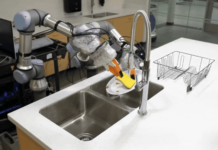A Revolutionary Approach with AI-Powered 3D Imaging for Breast Cancer Surgery
In the evolving landscape of medical technology, a groundbreaking innovation is set to redefine surgical procedures for breast cancer treatment. This innovation, developed by SimBioSys, a startup based in Illinois, utilizes artificial intelligence (AI) to transform traditional MRI scans into detailed, three-dimensional models of breast tissue. This new technology holds significant promise in enhancing the precision and efficacy of breast cancer surgeries.
Innovative Visualization with TumorSight Technology
SimBioSys has introduced a cutting-edge technology known as TumorSight, which leverages the power of AI to convert standard black-and-white MRI images into vibrant, volumetric depictions of a patient’s breasts. These 3D models allow different components of the breast to be clearly distinguished: veins might appear in red, tumors in blue, and surrounding tissues in gray. This color-coded system provides surgeons with an intuitive and interactive way to visualize and manipulate the data on a computer screen.
By offering a comprehensive view of the breast anatomy, TumorSight grants surgeons valuable insights that can significantly influence surgical decisions and treatment strategies. Key measurements related to surgery, such as the volume of a tumor or its proximity to the chest wall and nipple, are calculated with precision. This information is crucial in determining whether a breast can be preserved during surgery or if a mastectomy is necessary—a decision that has profound implications for a patient’s physical and emotional well-being.
The Growing Burden of Breast Cancer
Breast cancer remains a significant health challenge worldwide, affecting approximately 2.3 million women annually, according to the World Health Organization. The disease is responsible for over half a million deaths each year. In the United States alone, about 100,000 women undergo some form of mastectomy annually, as reported by the Brigham and Women’s Hospital. These statistics underscore the urgent need for advancements in breast cancer treatment.
Enhancing Surgical Planning through AI
Jyoti Palaniappan, the Chief Commercial Officer at SimBioSys, emphasizes the transformative potential of their visualization technology. Traditionally, surgeons have relied on radiology reports that provide limited information about a tumor’s size and location. Accessing additional details typically requires direct communication with a radiologist, which is not always feasible.
Dr. Barry Rosen, the Chief Medical Officer of SimBioSys, highlights the importance of standardizing presurgical imaging. The goal is to transition surgical planning from an art to a science by leveraging AI to enhance precision and consistency in surgical procedures. This approach not only improves surgical outcomes but also has the potential to set new standards in breast cancer treatment.
Harnessing NVIDIA Technology for Advanced Imaging
SimBioSys utilizes advanced computing technology from NVIDIA to power their AI models. This includes NVIDIA A100 Tensor Core GPUs, which are used in the cloud for pretraining AI models. Additionally, NVIDIA MONAI, a framework designed for medical imaging, is employed for training and validating data. The use of NVIDIA CUDA-X libraries, including cuBLAS and MONAI Deploy, further enhances the efficiency of SimBioSys’s imaging technology. Notably, SimBioSys is part of the NVIDIA Inception program, which supports startups in developing innovative AI solutions.
Bridging the Gap between Preoperative and Intraoperative Views
An intriguing aspect of SimBioSys’s innovation is its ability to reconcile MRI images taken with the patient lying face down into realistic 3D visualizations that mimic how the tumor and surrounding tissue will appear when the patient is lying face up on the operating table. This transformation is made possible by calculating the effects of gravity on breast tissue and considering the impact of skin elasticity on breast shape.
This capability is particularly valuable for surgeons as it provides a preview of what to expect during surgery, thereby enhancing their ability to plan and execute procedures with greater accuracy.
Aiming to Reduce Cancer Recurrence with AI
SimBioSys is also developing AI-driven strategies aimed at reducing the risk of cancer recurrence. Traditionally, pathology tests on removed tumors are conducted by hospital labs, with comprehensive molecular analyses performed by external labs. This process can take up to six weeks, delaying crucial decisions about subsequent treatment plans.
SimBioSys’s new AI model analyzes 3D volumetric features of the removed tumor, alongside the initial pathology report and patient demographic data, to generate a risk analysis within hours. This rapid assessment enables doctors to swiftly determine the most effective treatment strategies to prevent cancer recurrence.
A Cost-Effective and Efficient Alternative
According to internal studies conducted by SimBioSys, their new method of risk assessment matches or even surpasses traditional methodologies in predicting cancer recurrence, while also being significantly faster and more cost-effective. This advancement represents a major step forward in the fight against breast cancer, offering hope for improved survival rates and better quality of life for patients.
SimBioSys’s innovative approach to breast cancer treatment not only enhances the surgical process but also aligns with broader trends in healthcare that emphasize personalized and data-driven care. As this technology continues to develop, it holds the potential to transform how breast cancer is treated, offering new possibilities for patients and healthcare providers alike.
For further information regarding this technological innovation, you may visit the official SimBioSys website.
For more Information, Refer to this article.


































